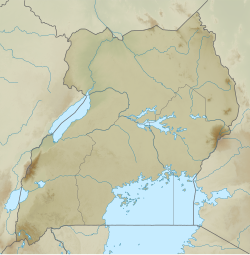The 1966 Toro earthquake, or the 1966 Ruwenzori earthquake, occurred on March 20 at 01:42 UTC (04:42 Uganda local time).[1] The earthquake was located near the border between Uganda and the Democratic Republic of the Congo (DRC), to the south of Lake Albert. Some sources put the epicenter in Uganda while some put it in the Democratic Republic of the Congo.[2]: 19 The earthquake had a magnitude of Mw 6.8[3]: 66 and a maximum perceived intensity of VIII (Severe) on the Mercalli intensity scale.[2]: 23
| UTC time | 1966-03-20 01:42:53 |
|---|---|
| ISC event | 849400 |
| USGS-ANSS | ComCat |
| Local date | March 20, 1966 |
| Local time | 04:42:53 |
| Magnitude | 6.8 Mw |
| Depth | 36 km |
| Epicenter | 0°51′N 29°52′E / 0.85°N 29.87°E[1] |
| Type | Dip-slip |
| Areas affected | Uganda, Democratic Republic of the Congo, and Tanzania |
| Max. intensity | MMI VIII (Severe) |
| Casualties | 157 killed (+90 in the May 18 aftershock) |
Tectonic setting
editThe earthquake occurred in the Mt Rwenzori region, which lies within the Western Rift Valley of the East Africa Rift System, between Lake Edward and Lake Albert. The Mt. Ruwenzori region is the most seismically active region in Uganda and also one of the most seismically active zones in the East Africa Rift System and is bounded by steep active normal faults.[4][5] The calculated focal mechanism for the earthquake was normal faulting in type,[6] although the focal mechanisms of three of the aftershocks were dominantly strike-slip in type.[7]
Damage
editExtensive damage was reported in both Uganda and the DRC. The earthquake caused 157 deaths: 104 in Uganda, one in Tanzania and 52 in the DRC. Buildings collapsed in both Uganda and the DRC.[2]: 26 In Bundibugyo, the Court Hall was damaged.[2]: 28 Cracks and fissures were observed on the ground. This earthquake could be felt in Uganda, the Democratic Republic of the Congo, Rwanda, Burundi, Tanzania, and Kenya.[2]: 21 Landslides triggered by the earthquake blocked roads, impeding relief efforts.[8]
According to press reports, a strong aftershock on May 18, 1966, caused 90 deaths in the DRC. This aftershock caused damage to buildings in both Uganda and the DRC.[2]: 18
Earthquake
editThe earthquake was associated with 20 km (12 mi) of surface faulting showing a downthrow of about 1.8 m (5 ft 11 in) to the southeast, consistent with one of the two possible fault planes from the focal mechanism.[6]
The earthquake was preceded by numerous foreshocks on March 18 and 19, 1966, and was followed by many aftershocks during the next two months, nine of them with a magnitude of 5.0 or greater.[2]: 17
The energy release of the main shock was about 2×1017 Nm. The energy release associated with aftershocks after April 18 was also significant. The sum of energy release of the aftershocks up to 45 days after the main shock was also about 2×1017 Nm, i.e. roughly equal to that of the main shock.[2]: 41
See also
editReferences
edit- ^ a b Engdahl, E. R.; Vallaseñor, A. (2002). "Global seismicity: 1900–1999" (PDF). International Handbook of Earthquake & Engineering Seismology. Part A, Volume 81A (First ed.). Academic Press. p. 681. ISBN 978-0124406520.
- ^ a b c d e f g h Loupekine, I.S. (July 1966). "Earthquake reconnaissance mission: Uganda the Toro earthquake of 20 March 1966" (PDF). UNESCO. Retrieved 5 May 2012.
- ^ Mavonga, T.; Durrheim R.J. (2009). "Seismic hazard in the DRC and Western Rift Valley of Africa" (PDF). 11th SAGA Biennial Technical Meeting and Exhibition Swaziland, 16–18 September 2009. p. 66. Archived from the original (PDF) on 2012-03-18. Retrieved 5 May 2012.
The Ruwenzori area experienced large earthquakes on 20 March 1966 (Mw 6.8)
- ^ "The seismicity and tectonics of Uganda" by N. Maasha
- ^ Twesigomwe, E.M. (1997). "Seismic hazards in Uganda". Journal of African Earth Sciences. 24 (1/2): 183–195. Bibcode:1997JAfES..24..183T. doi:10.1016/S0899-5362(97)00035-3.
- ^ a b Foster, A.N.; Jackson J.A. (1998). "Source parameters of large African earthquakes:implications for crustal rheology and regional kinematics". Geophysical Journal International. 134 (2): 425, 438. Bibcode:1998GeoJI.134..422F. doi:10.1046/j.1365-246x.1998.00568.x.
- ^ Zana, N.; Tanaka K. (1981). "Focal Mechanism of Major Earthquakes in the Western Rift Valley of Africa" (PDF). Tohoku Geophysical Journal. 28 (3–4): 126. Archived from the original (PDF) on 2013-12-11. Retrieved 5 May 2012.
[...] the tension axes are in the direction of east to west and that the pressure axes are about vertical direction. [...] Although the mechanism solutions obtained in this study include a large component of the strike slip faulting
- ^ National Geophysical Data Center. "Significant earthquake". Retrieved 5 May 2012.
External links
edit- The International Seismological Centre has a bibliography and/or authoritative data for this event.
